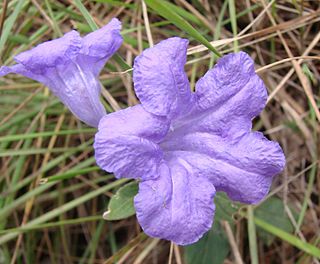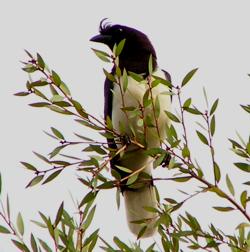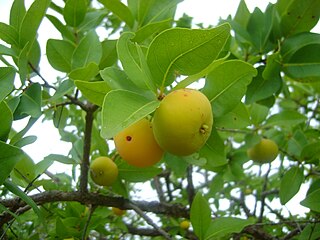
Erythrina is a genus of plants in the pea family, Fabaceae. It contains about 130 species, which are distributed in tropical and subtropical regions worldwide. They are trees, with the larger species growing up to 30 m (98 ft) in height. These species are known for their large flowers with long and bright red or orange petals.

Mimosa tenuiflora, syn. Mimosa hostilis, also known as jurema preta, calumbi (Brazil), tepezcohuite (México), carbonal, cabrera, jurema, black jurema, and binho de jurema, is a perennial tree or shrub native to the northeastern region of Brazil and found as far north as southern Mexico, and the following countries: El Salvador, Honduras, Panama, Colombia and Venezuela. It is most often found in lower altitudes, but it can be found as high as 1,000 m (3,300 ft).

Solanum lycocarpum, or wolf apple, is common in the Brazilian savanna, the Cerrado ecoregion. The plant is called lobeira or fruta-do-lobo in Portuguese.

The Cerrado is a vast ecoregion of tropical savanna in eastern Brazil, being present in the states of Goiás, Mato Grosso do Sul, Mato Grosso, Tocantins, Maranhão, Piauí, Bahia, Minas Gerais, São Paulo, Paraná and the Federal District. The core areas of the Cerrado biome are the Brazilian highlands – the Planalto. The main habitat types of the Cerrado consist of forest savanna, wooded savanna, park savanna and gramineous-woody savanna. The Cerrado also includes savanna wetlands and gallery forests.
The name Catuaba is used for the infusions of the bark of a number of trees native to Brazil. The most widely used barks are derived from the trees Trichilia catigua and Erythroxylum vaccinifolium. Other catuaba preparations use the bark of trees from the following genera or families: Anemopaegma, Ilex, Micropholis, Phyllanthus, Secondatia, Tetragastris and species from the Myrtaceae. Local synonyms are Chuchuhuasha, Tatuaba, Pau de Reposta, Piratancara and Caramuru.

Ruellia geminiflora, known locally as ipecacuanha-da-flor-roxa, is a species native to Argentina; Brazil, typically Caatinga and Cerrado vegetation; Guianas, and Venezuela. The roots of this plant contains possibly toxic substances.

Myracrodruon urundeuva is a timber tree, which is often used for beekeeping. This plant is native to Argentina, Brazil, Bolivia and Paraguay, and it is typical of Caatinga, Cerrado, and Pantanal vegetation in Brazil.

The curl-crested jay is a species of jay native to South America.
Anadenanthera colubrina var. cebil is a mimosa-like timber tree native to Caatinga and Cerrado vegetation in Argentina, Bolivia, Brazil, Paraguay and Peru. It has also been introduced to Mauritius. It grows up to 25 m (82 ft) tall, with a trunk diameter of 60–90 cm (24–35 in). The tree's mimosa-like leaves range in length from about 7–20 cm (2.8–7.9 in). The flowers are cream-colored and arrive in the spring. The seed pods are fairly straight and contain about 8 to 15 seeds each. The seeds are flat, average each about 1.5 cm (0.59 in) in diameter and have an average mass of about 0.125 g (0.0044 oz) each. The tree's wood has a density of about 840 kg/m3 (1,420 lb/cu yd).

Erythravine is a tetrahydroisoquinoline alkaloid found in the plant Erythrina mulungu and other species of the genus Erythrina.

Caatinga is a type of semi-arid tropical vegetation, and an ecoregion characterized by this vegetation in interior northeastern Brazil. The name "Caatinga" comes from the Tupi word ka'atinga, meaning "white forest" or "white vegetation" . The Caatinga is a xeric shrubland and thorn forest, which consists primarily of small, thorny trees that shed their leaves seasonally. Cacti, thick-stemmed plants, thorny brush, and arid-adapted grasses make up the ground layer. Most vegetation experiences a brief burst of activity during the three-month long rainy season.

Dipteryx alata is a large, undomesticated, edible nut-bearing tree from dryish tropical lowlands in central South America belonging to the legume family, Fabaceae, from the Dipterygeae tribe in the Faboideae subfamily. It is a wild species, widespread across the Cerrado savanna in South America. The baru nut seed is a grain legume, growing in popularity in North America as a snack food.

Mario Guimarães Ferri was a professor at the Universidade de São Paulo (USP). He was a research scientist, a lecturer, an editor, an administrator and also an artist. In his scientific work, he was a pioneer ecologist in Brazil. His power of communication linked to a great love of botany and the environment and a deep scientific knowledge made of him an exceptional lecturer. In his books and articles on science he informed the public about ecology and pollution – and in a very simple but precise language he presented the necessary data to understand the importance of the protection of the environment.

Erythrina velutina is a species of leguminous tree. It is indigenous to Brazil, Peru, Ecuador, Colombia, Venezuela, and Hispaniola and has been introduced to much of the Caribbean, Uganda, and Sri Lanka. It also occurs on the Galápagos Islands, but whether it is indigenous or introduced there is unclear. In Brazil, it occurs on plains and near rivers in the arid parts of the northeast of the country and is commonly known as "mulungu". Erythrina velutina grows as a large tree to around 10 m (30 ft) high and has short spines on the stem. It is perennial.

Eugenia dysenterica is a tree from the family Myrtaceae, native of the Cerrado, the central savannah region of Brazil. It is locally known by the Portuguese names cagaita or cagaiteira.

Bromelia laciniosa, natively known as macambira, is plant in the bromeliad family, or in other words, the pineapple family—though not all bromeliads resemble the common pineapple. Bromelia laciniosa is native to Brazil and Argentina but cultivated in many other places.

According to IBGE (2004), Brazil has its territory occupied by six terrestrial biomes and one marine biome.

Hymenaea stiginocarpa is an irregularly shaped, mostly 6–9 m (20–30 ft) high tree that has been assigned to the pea family. It has a twisted spindle-shaped trunk, a very rough grey bark, and reddish-brown twigs. The deciduous leaves consist of two large asymmetrical leaflets with an entire margin. The flowers occur in clusters of up to thirty at the end of the branches. It produces edible, highly appreciated fruits, which are often collected from the wild and used by local people. The vernacular name of this species in Brazil is jatobá do cerrado.

Campomanesia guazumifolia is a species of tree in the family Myrtaceae.



















